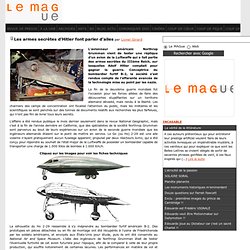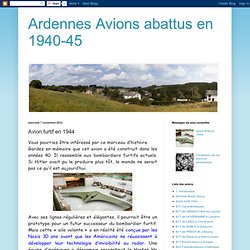

Horten Ho 229. Un article de Wikipédia, l'encyclopédie libre.

Horten Ho 229. The Horten H.IX, RLM designation Ho 229 (often, and wrongly,[1] called Gotha Go 229 because of the identity of the chosen manufacturer of the aircraft) was a German prototype fighter/bomber designed by Reimar and Walter Horten and built by Gothaer Waggonfabrik late in World War II.

It was the first pure flying wing powered by jet engines.[2] It was given the personal approval of German Luftwaffen Reichsmarschall Hermann Göring, and was the only aircraft to come close to meeting his "3×1000" performance requirements, namely to carry 1,000 kilograms (2,200 lb) of bombs a distance of 1,000 kilometres (620 mi) with a speed of 1,000 kilometres per hour (620 mph). Its ceiling was 15,000 metres (49,000 ft).[3] Design and development[edit] In 1943, Reichsmarschall Göring issued a request for design proposals to produce a bomber that was capable of carrying a 1,000 kilograms (2,200 lb) load over 1,000 kilometres (620 mi) at 1,000 kilometres per hour (620 mph); the so-called "3×1000 project".
Les armes secrètes d'Hitler font parler d'ailes. La fin de la deuxième guerre mondiale fut l’occasion pour les forces alliées de faire des découvertes stupéfiantes sur un territoire allemand dévasté, mais rendu à la liberté.

Les charniers des camps de concentration ont focalisé l’attention du public, mais les militaires et les scientifiques se sont penchés sur des tonnes de documents relatifs aux recherches les plus farfelues, qui n’ont pas fini de livrer tous leurs secrets. L’affaire a été rendue publique le mois dernier seulement dans la revue National Geographic, mais c’est à la fin de l’année dernière en Californie, que des spécialistes de la société Northrop Grumman sont parvenus au bout de leurs expériences sur un avion de la seconde guerre mondiale que les ingénieurs allemands étaient sur le point de mettre en service. Cliquez sur les images pour voir les fiches techniques. Pleine échelle Horten Ho 2-29. Hitler "Horten 2-29" Stealth Fighter Re-création »Cryptoworld.
Hitler's Stealth Fighter Top stealth-plane experts have re-created a radical, nearly forgotten Nazi aircraft: the Horten 2-29, a retro-futuristic fighter that arrived too late in World War II to make it into mass production.

The all-wing Ho 2-29 looked more like today’s U.S. B-2 bomber, or something from a Star Wars prequel – than like any other World War II aircraft. Made primarily of wood and powered by jet engines, the plane was designed for speeds of up to 600 miles an hour (970 kilometers an hour). The retro Horten 2-29 stealth fighter recreated. Ho 2-29 "Stealth Fighter Hitler" Luftwaffe Centre de ressources - Un site Warbirds Resource Group - Horton Ho 229. "Stealth Fighter Hitler" Re-création. June 25, 2009 Top stealth-plane experts have re-created a radical, nearly forgotten Nazi aircraft: the Horten 2-29, a retro-futuristic fighter that arrived too late in World War II to make it into mass production.

(See Hitler's stealth fighter in pictures.) The engineers' goal was to determine whether the so-called stealth fighter was truly radar resistant. In the process, they've uncovered new clues to just how close Nazi engineers were to unleashing a jet that some say could have changed the course of the war. Sleek, swift and deadly... Hitler's stealth bomber 'could have turned tide against Britain'
By Marcus Dunk Updated: 09:50 GMT, 8 July 2009 With its smooth and elegant lines, this could be a prototype for some future successor to the stealth bomber.

But this flying wing was actually designed by the Nazis 30 years before the Americans successfully developed radar-invisible technology. Now an engineering team has reconstructed the Horten Ho 2-29 from blueprints, with startling results. Blast from the past: The full-scale replica of the Ho 2-29 bomber was made with materials available in the 40s. Les guerres mondiales. Avion furtif en 1944. Vous pourriez être intéressé par ce morceau d’histoire.

Gardez en mémoire que cet avion a été construit dans les années 40. Il ressemble aux bombardiers furtifs actuels. Si Hitler avait pu le produire plus tôt, le monde ne serait pas ce qu’il est aujourd’hui. Avec ses lignes régulières et élégantes, il pourrait être un prototype pour un futur successeur du bombardier furtif. Mais cette « aile volante » a en réalité été conçue par les Nazis 30 ans avant que les Américains ne réussissent à développer leur technologie d’invisibilité au radar. Souffle du passé : La réplique à taille réelle du bombardier Ho 2-29 a été réalisée avec des matériaux disponibles dans les années 40.Il était plus rapide et plus efficace que n’importe quel avion de cette période et ses capacités furtives fonctionnaient contre les radars.